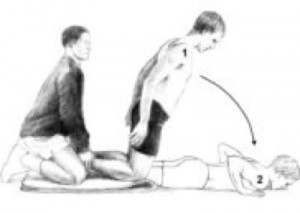Well, Thanksgiving is upon us in 2011. I want to wish you and your family a wonderful holiday. In today’s post I will review a November 2011 article in the American Journal of Sports Medicine that looked at the effect of the Nordic hamstring exercise on hamstring injuries in male soccer players.
For those not familiar with Nordic hamstring exercises, see the photo below:

In this randomized trial, the researchers had 54 teams from the top 5 Danish soccer divisions participate. They ended up with 461 players in the intervention group (Nordic ex) and 481 players in the control group. The 10 week intervention program was implemented in the mid-season break between December and and March because this was “the only time of the year in which unaccustomed exercise does not conflict with the competitive season.
The trial was conducted between January 7, 2008 and December 12, 2008 with follow-up of the last injury until January 14, 2009. In the intervention group, all teams followed their normal training routine but also performed 27 sessions of the Nordic hamstring exercises in a 10 week program (as follows)
- Week 1 – 2 x 5
- Week 2 – 2 x 6
- Week 3 – 3 x 6-8
- Week 4 – 3 x 8-10
- Weeks 5-10 – 3 sets, 12-10-8 reps
- Weeks 10 plus – 3 sets 12-10-8 reps
The athletes were asked to use their arms to buffer the fall, let the chest touch the ground and immediately get back to the starting position by pushing with their hands to minimize the concentric phase. The exercise was conducted during training sessions and supervised by the coach. The teams were allowed to choose when in training it was done, but they were advised not to do it prior to a proper warm-up program.
And the results…..
- Injury rates = 67 total with 44 new and 23 recurrent ones
- 15 of the injuries were in the intervention group (12 new and 3 recurrent)
- 52 injuries in the control group (32 new and 20 recurrent)
- 60% of injuries in the intervention group occurred during the 10 week training, whereas the corresponding number in the control group was only 23%
- No injuries occurred during the execution of the Nordic hamstring exercises
- Delayed onset muscle soreness was reported during the first 2 weeks of training for the intervention group
In a brief summary, the eccentric training reduced new injuries by more than 60% and recurrent injuries by about 85%. There was no statistical difference in severity of hamstring injuries . It has been shown in previous literature that when combined with stretching and warm-up the Nordic hamstring exercise has been effective in reducing injuries as much as 65% (Arnason et al).
This study has shown that the Nordic hamstring exercise alone is effective in injury prevention. Some limitations of the study were that it was not blinded and exposure time was not specifically linked with injury reporting (although the authors feel in a large sample like this it is not feasible to record individual playing/training time) nor do they feel all activities carry a high exposure risk.
In the end, I think we can agree that eccentric hamstring exercise is effective for preventing new and recurrent hamstring exercises. I must admit I was a bit surprised there were zero strains as a result of performing the exercises. I do like the exercise, but having done it I know it carries risk of muscle cramping (my calves once seized up) and proper form is essential. Novices should be eased in and counseled on muscle soreness.
The obvious benefits of the exercise beyond the injury prevention is that it requires no equipment and can be done in tandem in a relatively short period of time. When prescribing it, I think we must carefully consider form among the athletes, injury history and more importantly remember that the impact of the Nordic hamstring exercise is at the knee and not the hip joint.
So in translation, the Nordic hamstring exercise may be preferable for preventing common strains encountered with sprinting (many strains occur with decelerating the leg), but when dealing with higher hamstring strains I generally prefer more hip dominant eccentric exercises such as stiff legged dead lifts, single leg reaching and reaching lunges that emphasize hip flexion.
In addition, we must not forget the rotational component of the hamstrings either medial and lateral rotation), especially during injury assessment and rehab. So, in addressing complete hamstring prevention, training and rehab, remember to focus on the hip and knee joint as well as any rotational needs/demands of your athletes.

